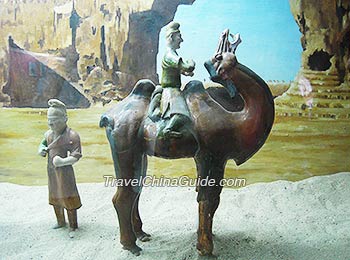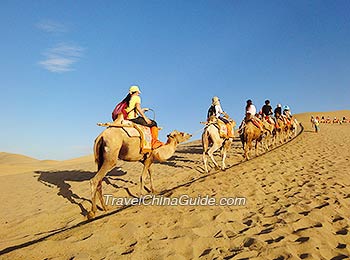Famous Travelers on the Silk Road
 |
| The Statue of Ancient Travelers on Silk Road |
In the history of the Silk Road, many renowned people left their footprints on this most historically important trade route, including eminent diplomats, generals and great monks, such as Zhang Qian, Ban Chao, Ban Yong and Fu Jiezi, Gan Ying, Xuanzang and Marco Polo.
Zhang Qian was the pioneer of the Silk Road who opened up this ancient trade road during the reign of the Han Emperor Wudi. From 139 BC to 119 BC, he went to the Western Regions twice and brought back an immense amount of information about the Central Asia and West Asia. The Silk Road marked the beginning of a new era with an extensive exchange of culture, economy and religion between China and the West.
 |
| Modern Travelers on Silk Road |
Besides, Feng Liao, Ban Chao, Ban Yong and Fu Jiezi all contributed greatly to ensure peace on the Silk Road. The famous generals – Wei Qing and Huo Qubing defeated the Huns, which let down the barriers along the trade route. In the Tang Dynasty (618–907), Xuanzang set out on his journey to India to study Indian sutras along the Silk Road and wrote a book – Pilgrim to the West in Tang Dynasty. Then in the Yuan Dynasty (1206-1368), Marco Polo came to China and stayed for 17 years. After he returned Venice, Marco Polo dictated The Travels of Marco Polo that was recorded by Rustichello da Pisa in 1298.
In the history of China, Han Dynasty (206BC–220AD) and Tang Dynasty made intermarriages with Hun, Wusun and Tibet further consolidated the stable environment along the Silk Road and expanded it. Many princesses left their familiar hometown and reached to the remote states on a diplomatic mission. Wang Zhaojun (one of the four most beautiful women in Chinese history) and Princess Wen Cheng (married with the King of Tibet) made important contributions to the smooth flow of the Silk Road.
The main travelers of the Silk Road were merchants who organized various caravans to cross the Gobi Deserts. Overcoming all kinds of hardships, they transported goods for sale between China and the West to gain great profit. Some religious disciples missionized their faith through this road. From nobles to beggars and prisoners, all kinds of people once had gone to their destinations by this world-famous Silk Road.